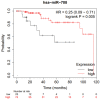Role and Involvement of TENM4 and miR-708 in Breast Cancer Development and Therapy
- PMID: 35011736
- PMCID: PMC8750459
- DOI: 10.3390/cells11010172
Role and Involvement of TENM4 and miR-708 in Breast Cancer Development and Therapy
Abstract
Teneurin 4 (TENM4) is a transmembrane protein that is codified by the ODZ4 gene and is involved in nervous system development, neurite outgrowth, and neuronal differentiation. In line with its involvement in the nervous system, TENM4 has also been implicated in several mental disorders such as bipolar disorder, schizophrenia, and autism. TENM4 mutations and rearrangements have recently been identified in a number of tumors. This, combined with impaired expression in tumors, suggests that it may potentially be involved in tumorigenesis. Most of the TENM4 mutations that are observed in tumors occur in breast cancer, in which TENM4 plays a role in cells' migration and stemness. However, the functional role that TENM4 plays in breast cancer still needs to be better evaluated, and further studies are required to better understand the involvement of TENM4 in breast cancer progression. Herein, we review the currently available data for TENM4's role in breast cancer and propose its use as both a novel target with which to ameliorate patient prognosis and as a potential biomarker. Moreover, we also report data on the tumorigenic role of miR-708 deregulation and the possible use of this miRNA as a novel therapeutic molecule, as miR-708 is spliced out from TENM4 mRNA.
Keywords: Teneurin 4 (TENM4); biomarker; breast cancer; metastasis; miR-708; target; tumor progression.
Conflict of interest statement
The authors declare no conflict of interest.
Figures





Similar articles
-
Identification of TENM4 as a Novel Cancer Stem Cell-Associated Molecule and Potential Target in Triple Negative Breast Cancer.Cancers (Basel). 2021 Feb 20;13(4):894. doi: 10.3390/cancers13040894. Cancers (Basel). 2021. PMID: 33672732 Free PMC article.
-
The miR-30 family: Versatile players in breast cancer.Tumour Biol. 2017 Mar;39(3):1010428317692204. doi: 10.1177/1010428317692204. Tumour Biol. 2017. PMID: 28347244 Review.
-
Integrated analysis of mRNA and miRNA profiles revealed the role of miR-193 and miR-210 as potential regulatory biomarkers in different molecular subtypes of breast cancer.BMC Cancer. 2021 Jan 18;21(1):76. doi: 10.1186/s12885-020-07731-2. BMC Cancer. 2021. PMID: 33461524 Free PMC article.
-
Exome Sequencing Identifies TENM4 as a Novel Candidate Gene for Schizophrenia in the SCZD2 Locus at 11q14-21.Front Genet. 2019 Jan 28;9:725. doi: 10.3389/fgene.2018.00725. eCollection 2018. Front Genet. 2019. PMID: 30745909 Free PMC article.
-
A comprehensive review on oncogenic miRNAs in breast cancer.J Genet. 2021;100:15. J Genet. 2021. PMID: 33764337 Review.
Cited by
-
Examples of Inverse Comorbidity between Cancer and Neurodegenerative Diseases: A Possible Role for Noncoding RNA.Cells. 2022 Jun 15;11(12):1930. doi: 10.3390/cells11121930. Cells. 2022. PMID: 35741059 Free PMC article. Review.
-
The Double Face of miR-708: A Pan-Cancer Player with Dissociative Identity Disorder.Genes (Basel). 2022 Dec 16;13(12):2375. doi: 10.3390/genes13122375. Genes (Basel). 2022. PMID: 36553642 Free PMC article. Review.
-
Han family with essential tremor caused by the P421L variant of the TENM4 gene in China.Neurol Sci. 2023 Jun;44(6):2003-2015. doi: 10.1007/s10072-023-06603-4. Epub 2023 Jan 23. Neurol Sci. 2023. PMID: 36689009

